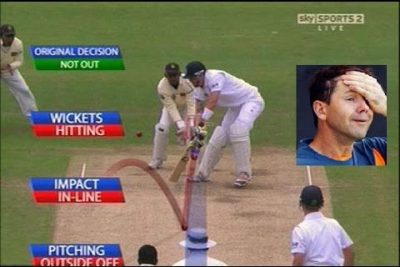Cricket, often called the gentleman’s game, is not only known for its thrilling matches and passionate players but also for the key gestures made by cricket umpires. These unsung heroes of the game possess a unique set of signals that communicate crucial decisions, from signaling a boundary to declaring a batsman out. In this article, we delve into the art of umpiring and explore the significance of these gestures, shedding light on the silent language that shapes the outcome of the game. Get ready to uncover the hidden world of cricket umpires and gain a newfound appreciation for their role in this beloved sport.
What do the umpire signals consist of?
Umpire signals in baseball encompass a series of concise and eye-catching gestures performed by the plate umpire. With their right hand, they signal key actions such as indicating play, strikes, outs, fair balls – signifying that “the ball’s alive.” In the rarest of occasions, the umpire’s right hand may also signal an “infield fly” or, hopefully even rarer, an ejection. On the other hand, the left hand is responsible for a myriad of other tasks, including awarding bases, controlling the pitcher’s actions, and securely holding the indicator and the mask. Together, these well-coordinated signals ensure clarity and efficiency in the game of baseball.
What is the meaning behind a cricket umpire tapping his shoulder?
When a cricket umpire taps his shoulder, it holds significant meaning in the game. This action serves as a signal for the allocation of penalty runs, a vital aspect of the sport. Placing one arm on the opposite shoulder signifies that the fielding team is awarded the penalty runs. However, if the umpire taps that shoulder, it implies that the penalties are instead granted to the batting team. These subtle gestures play a crucial role in maintaining fairness and clarity on the cricket field.
In the intricate world of cricket, every gesture and movement carries immense weight. The act of an umpire tapping his shoulder takes on a whole new level of significance. It is a concise and effective way to communicate the allocation of penalty runs. When the umpire places one arm on the opposite shoulder, it is a clear indication that the fielding team is being awarded these penalties. Conversely, if the umpire taps that shoulder, it implies that the batting team receives the penalty runs. This simple yet eye-catching action ensures that the game flows smoothly and maintains its integrity.
The tapping of the shoulder by a cricket umpire acts as a visual cue, guiding players and spectators alike. It is a concise and easily recognizable gesture that holds deep meaning within the sport. When an umpire taps his shoulder, it symbolizes the allocation of penalty runs. Placing one arm on the opposite shoulder designates the fielding team as the recipient of these penalties. However, a tap on that shoulder signifies that the batting team is being awarded the penalty runs instead. This subtle but effective communication method adds to the overall coherence and fairness of the game.
What signal does the umpire use during the cricket match?
During a cricket match, the umpire utilizes distinct signals to communicate with the players and spectators. One such signal is used to indicate a wide ball, where the umpire spreads both arms out at shoulder height. This eye-catching gesture instantly alerts everyone on the field that the ball has deviated too far from the prescribed area, resulting in an extra run for the batting team. Similarly, when a no-ball is bowled, the umpire employs another signal by extending his right arm at shoulder height. This concise and clear gesture signifies that the bowler has overstepped the mark, granting the batting team an additional run and an extra chance to score.
These well-defined and easily recognizable signals play a crucial role in maintaining fairness and transparency during a cricket match. The umpire’s use of spreading both arms out at shoulder height to indicate a wide, and extending the right arm for a no-ball, ensures that all players and spectators can quickly comprehend the decisions made. Moreover, these eye-catching gestures enable effective communication on the field, reducing confusion and promoting a smooth flow of the game. By employing these concise and coherent signals, the umpire ensures that the rules of cricket are upheld and the match progresses in a fair and engaging manner.
Unveiling the Enigma: Understanding Cricket Umpires’ Hand Signals
Unveiling the Enigma: Understanding Cricket Umpires’ Hand Signals
In the fast-paced world of cricket, umpires play a crucial role in ensuring fair play and maintaining the integrity of the game. However, their hand signals often leave spectators scratching their heads in confusion. With a myriad of gestures and signs, it can be hard to decipher what exactly the umpire is trying to convey. To unravel this enigma, let’s dive into the world of cricket umpires’ hand signals and gain a deeper understanding of their significance.
Cricket umpires’ hand signals serve as a universal language on the field, communicating important decisions and actions to players, fellow officials, and the audience. From signaling a boundary to indicating a dismissal, these gestures are designed to convey information quickly and efficiently. Understanding these signals not only enhances the spectator’s experience but also allows players to react accordingly in real-time. So, the next time you find yourself watching a cricket match, keep an eye out for these captivating hand signals that bring the game to life.
Cricket Umpires’ Secret Language: Deciphering Key Gestures
Cricket Umpires’ Secret Language: Deciphering Key Gestures
In the world of cricket, umpires communicate with players and fellow officials through a secret language of gestures. These concise and subtle movements convey crucial decisions and rulings, ensuring fair play and maintaining the integrity of the game. With just a flick of a finger or a slight nod of the head, umpires signal boundaries, wickets, and dismissals, captivating spectators and adding an intriguing layer to the sport. This silent dialogue between the umpires and players forms an invisible thread that weaves the game together, highlighting the beauty and complexity of cricket.
In the fast-paced world of cricket, key gestures by umpires hold immense significance. From raising the finger to signal an out to the dramatic sweep of the arms indicating a six, these gestures have become iconic symbols of the sport. They not only convey crucial decisions but also add an element of drama and excitement to the game. Through their precise and deliberate movements, umpires have the power to sway the outcome of a match, making them an integral part of cricket’s rich tapestry. So, the next time you witness these key gestures, take a moment to appreciate the skill and impact of these unsung heroes of the game.


